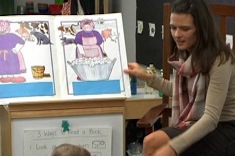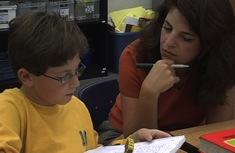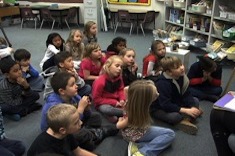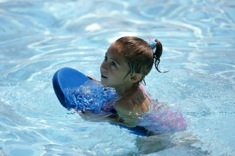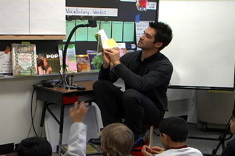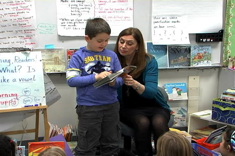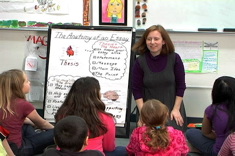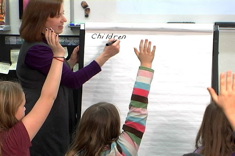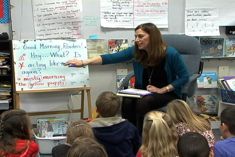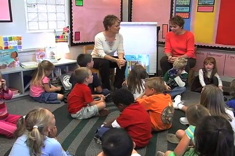Minilessons
Keeping it short, relevant, and meaningful is the challenge when it comes to designing lessons. Here is where you'll find practical advice and dozens of video examples of master teachers in action.
Latest Content
Helping Students Develop Independent Previewing Skills
Franki Sibberson's goal is to provide her students with more tools for previewing books independently and making wise selections. In this lesson, she makes full use of technology to set up sites and resources for students to browse at school or home.
A Picture Walk in Kindergarten
Mandy Robek takes her kindergartners through a picture walk using Mrs. Wishy Washy as the text.
Just Write More
Aimee Buckner has tips for ways to focus lessons that will help students produce more writing.
Teaching the Rule of Three to Writers
Aimee Buckner finds that teaching the rule of three to young writers adds variety to student texts.
Second-Grade Writing: Adding Details and Descriptive Language
In this first video from a four-part series, Sean Moore leads a writing workshop focused on adding more details and descriptive language to writing. He begins with the classic Charlotte’s Web as his mentor text.
Quick Sketch Practice
Linda Karamatic uses quick sketches to teach her second graders about sensory images in reading. This is the second installment in a two-part series.
Quick Sketch Sensory Images Read Aloud: Introduction
Linda Karamatic uses quick sketches to teach her second graders about sensory images in reading. This is the first installment in a two-part series.
Writing Workshop: Preparing for Publication
Beth Lawson helps her fourth-grade students work through a checklist of items to prepare for publishing early in the fall.
Launching a Punctuation Study in Second Grade
Linda Karamatic is launching a unit on punctuation with her second graders which includes mentor texts, inquiry, and anchor charts.
The Blank Page and Better Teaching
Aimee Buckner learns some important lessons about how images and words work together for student writers when she moves between second- and fifth-grade classrooms.
Interactive Read Alouds to Support Struggling Readers
Shari Frost explains how interactive read alouds are the “kickboards” of reading instruction, especially for struggling readers. She explains how one teacher used them to support a struggling reader in 3rd grade.
Writing, Graphic Organizers, and Mentor Texts
In this video from Sean Moore’s second-grade classroom, Sean demonstrates how to use a graphic organizer with his own writing as the mentor text.
Educating the Writer’s Palate
Helping high school students understand the sophisticated literary tastes of writers is just a cookie away in Ellie Gilbert’s classroom. Ellie pairs cardamon with irony to launch the school year with a metaphor and challenge.
Focused Independent Reading in Second Grade
Sean Moore demonstrates how he helps students focus their independent reading with preparation and then with discussion after reading.
Extreme Makeover: Revision Edition
Heather Rader finds short text and shared modeling of revision strategies are just the scaffolds students need to see the power of revision for improving writing.
Sixth-Grade Lesson: Editing for Conventions
In this lesson with her sixth graders, Pam Pogson talks about a goal many students have mentioned during writing conferences: editing for conventions. This brief lesson gives everyone a chance to brainstorm common errors and fixes.
Over the Top: Mystery Writing with Fourth Graders
Helping students navigate the boundaries between realistic fiction and fantasy can be tricky, especially when it comes to mystery writing. In this lesson from Beth Lawson’s fourth-grade classroom, Beth uses a top hat graphic to help students think through when writing is “over the top” in mysteries.
Narrative Nonfiction in 5th Grade Part 2
In this lesson from a 5th grade classroom, Aimee Buckner guides students in a note-taking process to help understand the qualities of nonfiction narrative writing. In this second part of the lesson, students share their notes and Aimee makes connections to additional mentor texts.
Nonfiction Read Aloud
Sean Moore reads nonfiction aloud to his 2nd grade students. This is the first video in a two-part series.
Nonfiction Read Aloud – Part 2
Here are some more tips for nonfiction read-alouds, based on Sean Moore's reading of Plants That Eat Animals.
Astrigs, Asterisks, and Letting Students Lead
In this video from Linda Karamatic’s second-grade classroom, Charlie shares his punctuation “find” of asterisks with his classmates. He is reading the book Miss Child Has Gone Wild by Dan Gutman.
Frogs as Learning Ambassadors Part 1: Literary Nonfiction in 4th Grade
Andrea Smith gets creative in teaching literary nonfiction to her 4th graders in this video series.
Essay Writing: Thesis Statements and Supporting Details Minilesson
Beth Lawson works with her 4th graders to develop essays with strong thesis statements and supporting details, using a folder organization system to highlight different thesis statements for each child. This is the first video in a series.
Essay Writing: Teacher Modeling
Beth Lawson works with her fourth graders to develop essays with strong thesis statements and supporting details, using a folder organization system to highlight different thesis statements for each child. This is the second video in a series.
Noticing Words in Second Grade
In this brief video from Linda Karamatic’s 2nd grade classroom, students share words they are noticing, and Linda talks about making revisions to the wall displays of words in the classroom. She also mentions the word “wretched” which the class discussed the previous day, and how the word might be used naturally in conversations.
The Sponge Summary Lesson Part 5
In this sequence of videos, Heather teaches a 4th grade class, using the analogy of a sponge to explain how summaries work. In this fifth video, Heather and students shift from “I do” to “we do” as students try test their summary writing skills with partners
The Sponge Summary Lesson Part 6
In this sequence of videos, Heather teaches a 4th grade class, using the analogy of a sponge to explain how summaries work. In this final video, Heather and students debrief and capture their learning in writing.
Previewing Nonfiction
Teachers are adding more nonfiction to their classroom libraries, and looking for ways to promote nonfiction with students in light of the emphasis on nonfiction in the Common Core. Franki Sibberson share tips for previewing nonfiction with students.
Grades K-2 Fluency Lesson
In this video from a K-2 multiage classroom, Joan Moser and Gail Boushey ("The Sisters") present a fluency lesson to the whole class.
On Their Own (Almost): Coaching and Classroom Demonstrations Mid-Year
In this video filmed in mid-January, Jennifer Allen observes new teacher Jessica, and explains how she struggles to redefine her role in the classroom.
Browse Content By
Type
Category
- Assessment Tools
- Big Fresh Archives
- Booklists
- Choice Numeracy
- Classroom Design
- Common Core
- Community Building
- Conferring
- Content Literacy
- Digital Literacy
- English Language Learners
- Equity
- Family Relations
- Free Samples
- Guiding Groups
- Leadership
- Literacy Coaches
- Mentor Texts
- Minilessons
- New Teacher Mentors
- Podcasts
- Poetry
- Quote Collections
- Reading Strategies
- Self Care
- Struggling and Striving Learners
- Talking and Listening
- Teacher Study Groups
- Teaching Reading
- Teaching Writing
- Word Study and Vocabulary
Author
- Melissa Quimby
- Nawal Qarooni
- Gwen Blumberg
- Julie Cox
- The Lead Learners
- Hannah Tills
- Josie Stewart
- Ruth Metcalfe
- Mallory Messenger
- Becca Burk
- Jodie Bailey
- Vivian Chen
- Mary Brower
- Tiffany Abbott Fuller
- Stephanie Affinito
- Ruth Ayres
- Leigh Anne Eck
- Heather Fisher
- Shari Frost
- Julie Johnson
- Suzy Kaback
- Gigi McAllister
- Shirl McPhillips
- Melanie Meehan
- Cathy Mere
- Debbie Miller
- Tara Barnett and Kate Mills
- Tammy Mulligan
- Dana Murphy
- Bitsy Parks
- David Pittman
- Brenda Power
- Heather Rader
- Matt Renwick
- Mandy Robek
- Christy Rush-Levine
- Gretchen Schroeder
- Jen Schwanke
- Brian Sepe
- Katherine Sokolowski
- Stella Villalba
- Jennifer Vincent
Grade Level
Choice Literacy Membership
Articles
Get full access to all Choice Literacy article content
Videos
Get full access to all Choice Literacy video content
Courses
Access Choice Literacy course curriculum and training


